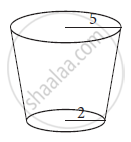Advertisements
Advertisements
प्रश्न
A parachutist is descending vertically and makes angles of elevation of 45° and 60° at two observing points 100 m apart from each other on the left side of himself. Find the maximum height from which he falls and the distance of the point where he falls on the ground form the just observation point.
उत्तर
Let BC be the height h of the parachutist and makes an angle of elevations between 45° and 60° respectively at two observing points 100 apart from each other.

Let AD = 100, CD = x, BC= h, and ∠CAB= 45°, ∠CDB = 60°
So we use trigonometric ratios.
In triangle BCD
`tan 60^@ = h/x`
`=> x = h/sqrt3`
Now in triangle ABC
`tan 45^@ = h/(x + 100)`
`=> 1 = h/(x + 100)`
=> x + 100 = h
`=> h/sqrt3 + 100 = h`
`=> h + 100sqrt3 = sqrt3h`
`=> h = (100sqrt3)/(sqrt3 - 1)`
`=> h = 50(3 + sqrt3)`
`=> x = h/sqrt3`
`x= (50(3 + sqrt3))/sqrt3`
`= 50(1 + sqrt3)`
Hence the maximum height is `50(3 + sqrt3)m = 236.6 m`
and distance is `50(1 + sqrt3)m = 136.6 m`
APPEARS IN
संबंधित प्रश्न
The angles of elevation of the top of a tower from two points at a distance of 4 m and 9 m from the base of the tower and in the same straight line with it are 60° and 30° respectively. Find the height of the tower.
At the foot of a mountain the elevation of its summit is 45º; after ascending 1000 m towards the mountain up a slope of 30º inclination is found to be 60º. Find the height of the mountain.
On a straight line passing through the foot of a tower, two points C and D are at distances of 4 m and 16 m from the foot respectively. If the angles of elevation from C and D of the top of the tower are complementary, then find the height of the tower.
The angles of depression of the top and bottom of a tower as seen from the top of a 60 `sqrt(3)` m high cliff are 45° and 60° respectively. Find the height of the tower.

Radii of the top and the base of a frustum of a cone are 5 cm and 2 cm respectively. Its height is 9 cm. Find its volume. (π = 3.14)
From a point on the ground, 20 m away from the foot of a vertical tower, the angle elevation of the top of the tower is 60°, What is the height of the tower?
A ladder 15 m long just reaches the top of a vertical wall. If the ladder makes an angle of 60° with the wall, then the height of the wall is
If the angle of elevation of a cloud from a point ‘h’ metres above a lake is θ1 and the angle of depression of its reflection in the lake is θ2. Prove that the height that the cloud is located from the ground is `("h"(tan theta_1 + tan theta_2))/(tan theta_2 - tan theta_1)`
The angle of elevation of the top of a tower from certain point is 30°. If the observer moves 20 metres towards the tower, the angle of elevation of the top increases by 15°. Find the height of the tower.
Find the angle of elevation of the sun when the shadow of a pole h metres high is `sqrt(3)` h metres long.
